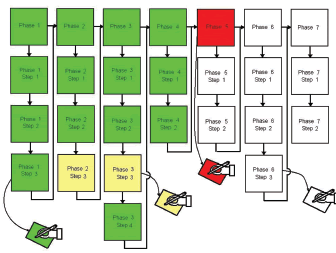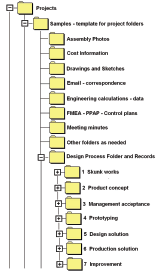Latest News
October 14, 2007
By Mike Janitz
 A simple seven-phase product development process with supporting steps and linked forms. |
I have heard about, seen, or participated in numerous product development systems. Some of them were called advanced product quality planning (APQP), management reviews, engineering design reviews, and the 8D problem solving process. No matter what system you implement, the development activities and records need to be created, stored, and retrievable not to mention legible, accurate, and complete. I want to share a process by which a project engineer can document, track, and record R&D tasks.
The System Tools
To hit your target you must first set one. Product development these days is measured by meeting the targets of quality, cost, and timing. The design of the product must conform to or exceed customer expectations (quality). The design dollars must be less than spending limits (cost). The design activity must be scheduled to meet resource constraints, market needs, and expectations (timing is everything!).
The product development process I suggest is a seven-phase system: (1) skunk works; (2) product conception; (3) management acceptance; (4) prototyping; (5) design solution; (6) production solution; and (7) improvement. Each phase can overlap its predecessor or successor. Each phase consists of multiple steps with infinite variation, and allows for redefining the targets. Moreover, one always has the opportunity to stop or change direction altogether.
Rather than delve deeply into the seven phases, it is more useful to describe a set of tools the project engineer can use to document the phases, track the progress, and store the records of a particular undertaking. These tools facilitate reporting the project’s status to the management team instantly and uses software applications that are probably already on your computer. You will probably recognize the flowchart, hyperlink ability, and file management solutions by their common names of Microsoft Word, Project, Windows Explorer, Excel, ABC Flow Charter, and Visio.
The Method
 This template of the file structure is a folder kept on a shared drive. It contains subfolders, the process map, schedule, and related forms. |
The system starts with a template — file structure. This template is a folder kept on a shared drive (see illustration, left). The template folder contains subfolders, the process map, project schedule, and related forms. These subfolders categorize project information. The subfolder “Design process folder and records” is structured like the seven phases (no forms shown).
The intent is to copy the entire sample template into a new location each time a project is started. By copying the template, the basic links are already in place, allowing the project engineer to use them or modify them. All forms are copied, which allows the project team to use them in whole, in part, or discard them. By copying the sample template, projects start the same way so that nomenclature, links, and forms are consistent, allowing for smoother communication between different functions and levels.
Documenting
In general, design projects start the same. The flowchart template has the seven phases broken down into smaller steps. Those smaller steps are hyperlinked to forms within the design process folder. Just like the flowchart, the master schedule is hyperlinked to other files. By hyperlinking these, the project engineer can easily find the appropriate file or form. Hyperlinking allows the project engineer to determine if the step and form are necessary.
Tracking
Tracking the project is easy. The flowchart starts in black and white. Then each step is coded in color (see illustration on page 44). As the project moves forward, the project manager uses a coloring system to depict project status. For example, the project engineer colors all completed steps in green to indicate steps are complete. A yellow step indicates the task has an issue needing attention. If the step is red that indicates the task is at risk of blowing the schedule or has an unresolved roadblock.
Since the color-coded steps are hyperlinked to their records, anyone can click the record to read the details. Now project design engineers and team members can report quickly and have records at their fingertips just by using the flowchart as the reporting tool.
Records
‘Say what you do and do what you say’ should be the creed of any quality management system concerning new product development. A good product development process has provisions to record appropriate data in a manner that is in conformance with the management system and complements the project’s complexity.
By starting each project with a template, the project team is assured of starting with the basic requirements covered — taking into account that the template is populated correctly and that it is updated and maintained over time.
Hyperlinking is not new. Using it this way takes the guesswork out of the process. However, the project engineer managing the project must realize when and where to modify the template steps. It is up to him or her to know when to add links and modify forms to meet the needs of the project.
Plan!
It all starts and ends with a plan. It must be a comprehensive plan that covers virtually all situations and a plan the project team can manipulate to fit the scope of any project, preloaded with known options such as forms, files, and structure.
What does it take to get started? First, define your product development process; second, create a process map and timeline; third, create reports or forms; and fourth, start linking them. Start with the flowchart and construct your links. Populate the forms — link them to other supporting information.
It takes a few times using the template before it is comfortable, but once in place, the team will start projects the same way and follow the same steps and have consistency between nomenclature and content. After all, it is not the process driving the design, it is the team using the process to create the best design that wins.
Mike Janitz is an engineering manager for Delta Consolidated Industries and has an M.S. in engineering management from OklahomaState University. He has more than 20 years of experience in automotive, marine, and aerospace-related industries. You can send an e-mail about this article to DE-Editorsmailto:[email protected].
Subscribe to our FREE magazine, FREE email newsletters or both!
Latest News
About the Author
DE’s editors contribute news and new product announcements to Digital Engineering.
Press releases may be sent to them via [email protected].






